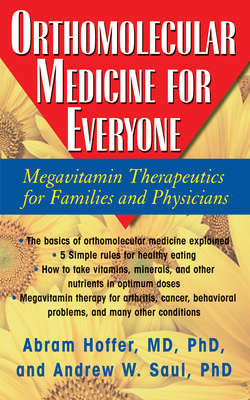Читать книгу Orthomolecular Medicine for Everyone - Abram Hoffer M.D. Ph.D. - Страница 51
Arthritis
ОглавлениеThe world was still deep in the Great Depression when William Kaufman, Ph.D., M.D., began treating osteoarthritis with 2–4 g (2,000–4000 mg) of niacinamide daily. Now, nearly seventy years later, his pioneering work in orthomolecular medicine is receiving the recognition it so well deserves. By 1950, Dr. Kaufman had already published two books detailing the beneficial effects of vitamin B3 for arthritis. Dr. Kaufman presented meticulous case notes for hundreds of patients, along with specific niacinamide dosage information applicable to both osteoarthritis and rheumatoid arthritis. In addition, he added some remarkably prescient observations on the antidepressant/antipsychotic properties of B3.
Dr. Kaufman, known as a conservative physician, was nevertheless the first to prescribe as much as 5,000 mg of niacinamide daily, in many divided doses, to improve range of joint motion. In previously unpublished comments, Dr. Kaufman noted that “niacinamide is a systemic therapeutic agent. It measurably improves joint mobility, muscle strength, (and) decreases fatigability. It increases maximal muscle working capacity, (and) reduces or completely eliminates arthritic joint pain.”
Regarding dosage, he stated that “the (more frequent) 250 mg dose of niacinamide is 40 to 50 percent more effective in the treatment of arthritis than the (less frequent) 500 mg dose. Niacinamide (alone or combined with other vitamins) in a thousand patient-years of use has caused no adverse side effects.” But he also urged a conservative approach: “Some joints are so injured by the arthritic process that no amount of niacinamide therapy will cause improvement in joint mobility, but it takes three months of niacinamide therapy before you can conclude this, since some joints are slow to heal.”5
In his book The Common Form of Joint Dysfunction, Dr. Kaufman stated that “It has been demonstrated empirically that even persons eating a good or excellent diet according to present-day standards exhibit measurable impairment in ranges of joint movement which tends to be more severe with increasing age. It has also been demonstrated that when such persons supplement their good or excellent diets with adequate amounts of niacinamide, there is, in time, measurable improvement in ranges of joint movement, regardless of the patients’ ages. In general, the extent of recovery from joint dysfunction of any given degree of severity depends largely on the duration of adequate niacinamide therapy.”6
One of Dr. Kaufman’s patients was so severely arthritic that he could not bend his elbows enough for a blood pressure measurement. Dr. Kaufman gave him niacinamide for a week in divided doses, and then he could bend his arm. After then taking him off the B3 and giving him a look-alike medicine (placebo) for a week, the patient was back where he started: his joints were stiff again. “I arrived at my (megavitamin B3 dosage) schedule by actually seeing the response of patients with varying degrees of arthritis,” stated Dr. Kaufman. “One cannot give a single large dose and get any really favorable results in arthritis … It is necessary to divide the doses so that the blood levels of niacinamide would be fairly uniform throughout the waking day.”7
His findings were both plain and elegant: the greater the stiffness, the more frequent the doses. Severely crippled arthritic patients needed up to a total of 4,000 mg per day, divided into ten doses. In one to three months, patients could now get out of their chair or bed. “If continued, they would be able comb their hair and be able to walk upstairs, so they would no longer be prisoners of the house. By the end of about three years’ treatment, they would be fully ambulatory, and this was even in the older age groups.”8
